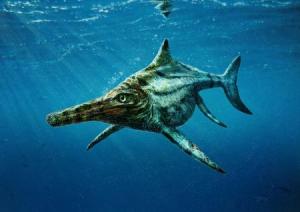The newly identified prehistoric marine reptile Dearcmhara shawcrossi, a member of a group called ichthyosaurs …
by Will Dunham
 Scotland has its very own prehistoric marine reptile - and,
no, we're not talking about Nessie, the mythic Loch Ness monster.
Scotland has its very own prehistoric marine reptile - and,
no, we're not talking about Nessie, the mythic Loch Ness monster.
Scientists have announced the discovery of the fossil
remains of a dolphin-like seagoing reptile on Scotland's Isle of Skye
that lived about 170 million years ago and was about 14 feet (4.3
meters) long.
The creature, named Dearcmhara
shawcrossi, is a member of a group called ichthyosaurs that were among
the dominant marine reptiles when dinosaurs ruled the land.
Ichthyosaurs, some of which reached monstrous proportions rivaling all
but the largest of today's whales, thrived for more than 150 million
years until disappearing about 95 million years ago.Dearcmhara, a moderate-sized ichthyosaur, swam in warm, shallow seas during the Jurassic Period, eating fish and squid. Its remains are incomplete but the shape of a bone in its front flippers suggests it may have been an especially strong or fast swimmer, the researchers said.
"It is from Scotland, and is the first uniquely Scottish
marine reptile ever discovered and studied," said University of
Edinburgh paleontologist Steve Brusatte, one of the researchers in the
study published on Monday in the Scottish Journal of Geology.
"Many other marine reptile fossils have been found in
Scotland, but the vast majority of these have disappeared into private
collections or been sold. This new specimen finally breaks the impasse:
it was found by a private collector who did a great thing, donated it to
a museum and worked with scientists," Brusatte added.
Amateur fossil hunter Brian Shawcross found the fossils on
a beach in the northern part of the Isle of Skye in 1959 and donated
them in the 1990s, researchers said. The genus name Dearcmhara
(pronounced "jark vara") is Scottish Gaelic for "marine lizard." The
species name honors Shawcross.
"It is important to emphasize how grateful we are that
Brian donated the bones he found all those years ago," added
paleontologist Neil Clark of the University of Glasgow's Hunterian
Museum, which received the fossils.
The discovery sheds light on a span of the Jurassic
regarded as nearly a black hole in the marine reptile fossil record,
Brusatte said. Scotland is one of the few places with fossils from that
time.
Other
fossils indicate Dearcmhara lived alongside members of another branch of
marine reptiles called plesiosaurs, known for long necks and
paddle-like flippers. The elusive Nessie is commonly portrayed as
looking like a plesiosaur.

No comments:
Post a Comment